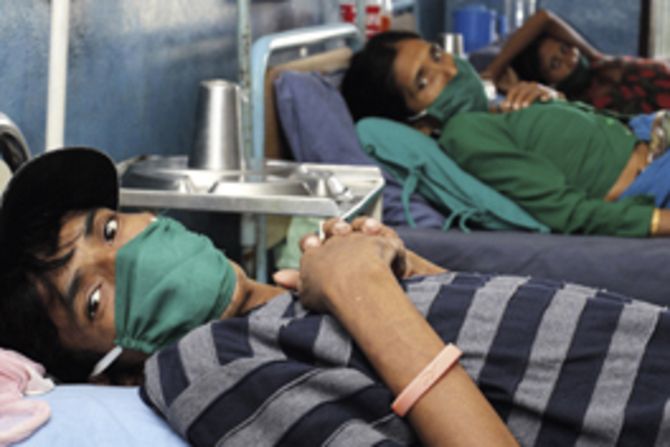He hoisted tents, supplies and oxygen cylinders up to the base camp on the over 8,000 metre high mountains, to Annapurna and to Mount Everest. Until he himself could hardly breathe.
“The loads became heavier. It seemed as if the air was becoming thinner and thinner.” The 35 year old Nepalese tried to suppress his cough, fought against the slow loss of weight, power and life-energy. “But I had to earn money for my wife, the little daughter and our newly born son.”
Madan lost his job. A doctor from the Nepalese Highlands said that his physical degeneration was attributable to typhoid fever. That was a false diagnosis. Madan took the wrong medicine. When the hospital in Nepalgunj finally recognized his pulmunary tuberculosis, he was near to death. Madan suspects that he became infected during one of the expeditions. “No wonder, if all day long labourers sit in stuffy tents on limited space for weeks”, says Hikmat Khadka.
Surviving under extreme circumstances
Khadka is director of the Reference Centre for tuberculosis in Nepalgunj, which has been supported by DAHW German Leprosy and Tuberculosis Relief Association since 1973. The hot and dusty city is located in the Nepalese lowlands, on the border with India. Most of the patients come from the mountain areas where poverty is an ideal as well as fatal breeding ground for tuberculosis. “The fields are barren and the people have one-sided meals that are also deficient in vitamins”, explains Hikmat Khadka. “Additionally, there is extreme coldness, lack of hygiene, choking smoke from hearth fires and the ignorance of people who never learned how to write or read.”
The hard way to recovery
Last year 32,000 patients went to the hospital in Nepalgunj. 14,000 sputum specimens were examined and more than 1,000 patients were even given inpatient treatment. In many cases tuberculosis is resistant to the commonly used antibiotics. Those people affected have to face a lavishly, very costly and 20-month lasting therapy.
Madan (right) together with other TB patients in the hospital’s garden in Nepalgunj. Photo: Bauerdick / DAHW
Women, like very thin Alma or anaemic and emaciated Mina, who is in an advanced stage of pregnancy with her third child, while her husband, a labourer, earns money in India.
Mina requires intensive care so as not to endanger her and her third child’s life. That is why DAHW is supporting the hospital especially when it comes to personnel costs. Without nurses in Nepalgunj, patients like Alma and Mina were not even able to put medicine into their mouth.
The high mortality rate of people suffering from tuberculosis in Nepal has a particular reason: “In remote regions where people have to live on the edge of the subsistence level, regular intake of medication is not guaranteed”, says hospital director Hikmat Khadka. But that is the only way to recovery. If they don´t take the medication regularly, dangerous resistances can arise. Therefore DAHW in Nepal supports the so called DOTS-System (“Directly Observed Treatment”).
The DOTS-System relies on a medical consultation with patients and strict control of intake of the life-saving medication. But then, Madan would have to walk four hours every day across the mountains to reach the next health post to receive his medication.
For a healthy person even they route would be exhausting, but for Madan´s lung it would be a torture with which he cannot cope. That is why Madan stays in Nepalgunj for treatment. He has not seen his family for six months. But he knows what the painful separation is worth. “When I return, I will be in good health.”
Overview Annual Report 2011



